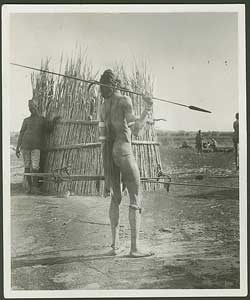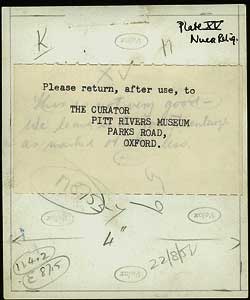Photographer
- John E. Allen
- Richard Buchta
- Jean Carlile Buxton
- E. E. Evans-Pritchard Collection:
- Godfrey Lienhardt
- Charles Kingsley Meek
- G. N. Morhig postcard series:
- Percy Horace Gordon Powell-Cotton
- Charles Gabriel Seligman slide collection
- Wilfred Patrick Thesiger
Major-Gen. Sir Charles William Gwynn (1870-1963)
View photographs by Major-Gen. Sir Charles William Gwynn.
Charles W. Gwynn (later Major-General Sir) was a Lieutenant in the Royal Engineers who worked (along with a Lieutenant L.C. Jackson) on the demarcation of the Sudan-Abyssinian border during 1899-1900. In particular they demarcated the stretch between the Blue Nile and the Sobat River, identifying areas of Abyssinian influence. They had a native officer on the trip, one Farag Effendi, who only spoke Arabic, who may be the native officer seen to the left of the prophet in the image. Their survey was carried out from north to south, arriving at Nasir in Feb 1900, where they marched downstream arriving at Fashoda on April 2nd.
As Evans-Pritchard acknowledges in the preface to Nuer Religion , the photograph reproduced in the book was made from a negative lent by Gwynn, probably some time shortly before the publication of Nuer Religion in 1956. Evans-Pritchard did not photograph any prophets himself due to their suppression by the administration in the years before 1930 when he began fieldwork. In Nuer Religion (p.307) he notes that 'The photograph of a prophet in Plate XV was taken by Major-General Sir Charles Gwynn early in the present century. We see from it how different is the appearance as well as the representation of a prophet from that of a priest!'
 Plate XIII Nuer Religion 1998.346.360
Plate XIII Nuer Religion 1998.346.360
 Reverse of 1998.346.360
Reverse of 1998.346.360
Douglas Johnson [11/5/2004] has noted about the image that it may have been taken 'in the area around Jokau or Itang - in the Gaajak or Gaajok territory. At that time there were a number of minor prophets in the border area, who were acknowledged dayiemni of Ngundeng. However, I cannot say that this is a picture of a dayiem , or even a "prophet" in the sense that E-P used the term. It is likely that Gwynn merely identified the person as a kujur , which could have covered a prophet ( guk ), subordinate prophet ( dayiem ), or magician ( gwan wal ).'
Gwynn published an influential and widely-read volume, Imperial Policing (MacMillan and Co. 1934).

